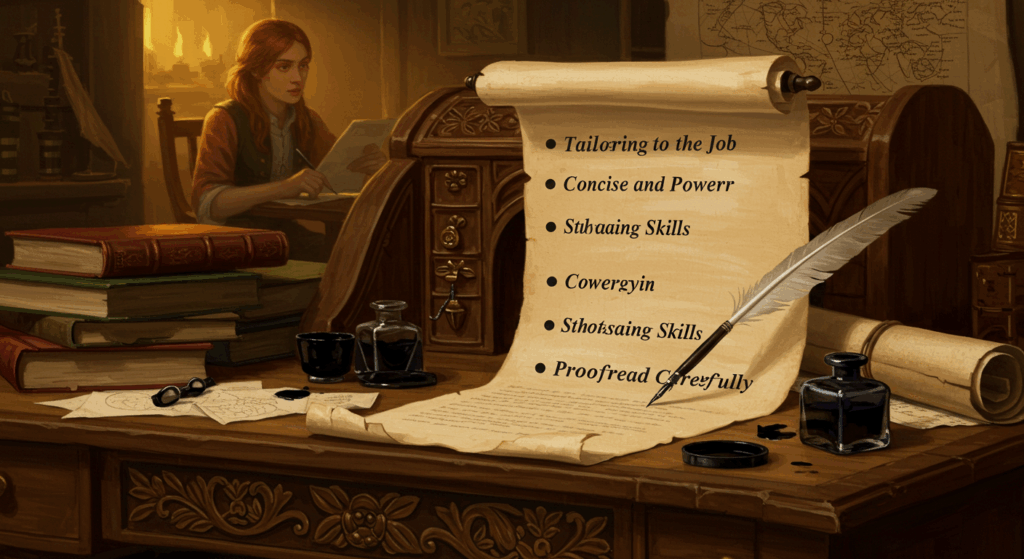If you’ve ever stared at a job listing and thought, “Ugh, another thing to write?!”, yeah—same. Job applications already feel like a mini-boss fight: résumé, portfolio links, those weird portal questions (why do they always ask me to re-type what’s literally on my résumé?), then boom: “Please attach a cover letter.” Ngl, it’s tempting to skip it. But here’s the twist: a good cover letter is one of the few places you can sound like an actual human, not a bullet-point robot. And that’s exactly why it still matters.
Let’s talk about what a cover letter on an application actually is (the real definition), why it still has importance, and some tips to make yours feel easy, honest, and… dare I say… fun-ish? We’ll keep it casual, like you and me swapping life hacks over iced coffee. A few tiny typos may sneak in—because we’re being human here, you know—but the advice is crisp and copy-paste ready for your next post or portal.
What Is a Cover Letter on an Application? (Real-World Definition)
At its simplest, a cover letter is a short, personalized note that accompanies your résumé in job applications. It explains why you’re applying, how your skills map to the role, and what makes you, well, you. Think of it as the trailer to your career movie: not the full plot (that’s your résumé), just the part that makes the hiring manager go, “Okay, I want to see more.”
Quick Definition You Can Remember
A cover letter is a one-page narrative that connects your experience to a specific job, shows you understand the company’s needs, and makes a case for why you’re a great match—both in skills and vibe. The definition isn’t complicated; the magic is in the tailoring.
Wait, Isn’t My Résumé Enough?
Your résumé is the receipt; your cover letter is the story. The résumé lists what you did. The cover letter explains why it matters for this role. If your résumé is the facts, the cover letter is the context. And context converts.
Why Cover Letters Still Matter (The Practical Importance)
You’ve probably heard the myth: “No one reads cover letters anymore.” Sometimes true, sometimes false. It depends on the company, the hiring manager’s style, and how many applicants they’re sifting through. But here’s the honest tea:
- A lot of hiring managers skim cover letters to feel your communication style and motivation.
- If there’s a tie between two candidates, a sharp cover letter can be the tie-breaker.
- When your experience looks “non-traditional,” the letter is your bridge. That’s kinda its core importance.
When a Cover Letter Is Extra Useful
- Career changes: You’re pivoting from hospitality to marketing? Use the letter to connect the dots.
- Early career or post-grad: If your résumé’s light, the letter shows potential, mindset, and clarity.
- Remote roles: Culture fit, self-motivation, and communication matter more—say it out loud in the letter.
- Competitive companies: When everyone’s qualified, your voice becomes the differentiator.
When You Can Keep It Super Short
- High-volume applications (retail/seasonal, etc.): A tight 2–3 paragraph note can still help.
- Referral scenario: If a trusted employee already vouches for you, the letter can be concise and confirm alignment.
The Role of a Cover Letter in the Whole Application
Imagine the “application” as a little squad:
- Job listing: The map of what they want.
- Résumé: Your proof of skills and impact.
- Cover letter: Your interpretation of their needs + your story about solving them.
- Portfolio/Links: Your receipts that those claims are real.
- LinkedIn: Your public-facing brand.
The cover letter is the connective tissue. It makes the leap from “I’ve done X” to “I can do X for you, here’s how.”
Anatomy of a Great Cover Letter (Mix of Definition, Importance, and Tips)
You don’t need to reinvent the genre—just do the basics really well. Here’s the structure (with plenty of tips):
1) Header & Contact Info
- Your name, email, phone, LinkedIn/portfolio link.
- Company name, role title, and—if you have it—the hiring manager’s name.
- Keep it clean. No wild fonts. Think easy-to-read and ATS-friendly.
2) Greeting That Doesn’t Make Them Cringe
- If you have a name: “Hi [Name],” or “Dear [Name],” works.
- If you don’t have a name: “Hi [Team/Department] Hiring Team,” is better than “To Whom It May Concern,” which low-key screams 2004.
3) The Hook (Opening Paragraph)
- In 1–3 sentences: name the role, say why you’re excited, and hint at your unique angle. Be human, not formal-robot.
- Good approach: “I’m applying for the [Role] because I love [specific part of their mission/product] and I’ve shipped [relevant outcomes].” Short, specific, real.
4) Core Value Paragraph(s)
- Choose 2–3 relevant strengths that map directly to the job ad.
- Use small evidence or mini-metrics: “In six months, I improved X by 27%,” “Shipped a feature used by 120k users,” “Led a four-person team to deliver Y on time.”
- Use their language where it makes sense. If they say “cross-functional collaboration,” you can say it too—just don’t overdo it.
5) Culture/Team Fit Note
- Sprinkle in a sentence about why this company. Not generic “I admire your innovation…” but something you noticed: a product update, a campaign, a mission line, a community angle.
- Keep it warm and credible.
6) Close with Momentum
- Invite next steps: “I’d love to share how I’d approach [problem area in the job ad].”
- Keep it gracious but confident: “Thanks for considering my application; I’m excited to contribute to [team].”
- Signature, and optionally a short P.S. with an extra spark (like a link to a tiny relevant project).
The “Voice” of Your Letter: Friendly, Clear, Competent
You’re not writing a legal brief. You’re writing like a thoughtful, capable human who knows their stuff. Yes, be professional—but you can be warm and a tad casual. That blend is modern. Imagine talking to a future teammate you respect. If your vibe is Netflix-rec queue meets Slack etiquette, you’re in the right lane.
Tone Tips (Because, yes, tips matter)
- Avoid buzzword salad. It’s predictable and boring.
- Use simple, active language.
- Replace “I am writing to express my interest” with “I’m excited about…” or “I’m applying for…”.
- Use specifics over vague claims: “Grew newsletter CTR from 2.1% to 5.3%” > “Improved engagement.”
The “Definition, Importance, Tips” Cheat Sheet
Because you asked for it to be woven in naturally, here’s a quick mini-poster version:
- Definition: A tailored, one-page narrative that connects your experience to a specific role and company, showing how you’ll solve their problems and fit their culture.
- Importance: It humanizes your application, bridges gaps (like industry pivots), highlights intent, and can edge you past similarly qualified candidates.
- Tips: Keep it one page; tailor to the job ad; show 2–3 proof points; mirror the company’s language lightly; and end with a confident, specific call-to-action.
What to Include vs. What to Skip
Include
- Role name and why you care.
- 2–3 relevant achievements (numbers if possible).
- An explicit tie to the company’s product/mission/team.
- A sense of what you’ll do in the first 90 days.
Skip
- Your entire résumé re-pasted into paragraphs.
- Apologies for lack of experience. (Reframe as eagerness to learn—backed by relevant projects.)
- Empty flattery. Compliments are cute, but specifics are convincing.
Formatting and Length (Keep It Clean)
- Length: Aim for 250–450 words (one page max). Brevity is respect.
- Font & Size: Something standard and legible (think system fonts). 10.5–12pt.
- File Type: PDF is safest unless the portal demands DOCX or a text box.
- File Name:
Firstname-Lastname-Cover-Letter-Role.pdf - Spacing: 1.0 or 1.15 with clear paragraphs. White space = breathability.
Tailoring 101: The Fastest Way to Customize
You don’t need to start from scratch every time. Use a base and tweak:
- Mirror the priority skills in the job ad. If they emphasize “client communication” and “HubSpot,” use those exact words (where true).
- Swap in a company-specific hook. Mention a recent launch, customer segment, or mission detail.
- Match your top 2–3 achievements to their outcomes. If they want “lifecycle marketing,” bring your retention metrics. If they want “data-driven,” bring your experiment wins.
A Simple Tailoring Template (Copy-Paste Ready)
- Opening: “I’m applying for [Role] because [specific reason tied to their product/mission].”
- Middle #1: “In my last role, I [achievement] which led to [result]. That maps to your need for [requirement from job ad].”
- Middle #2: “I also [second achievement], which supports [another requirement].”
- Culture: “I’d love to help [company/team] with [specific project or challenge].”
- Close: “Happy to share how I’d approach [problem area]. Thanks for reading—excited to connect.”
Examples (Micro-Templates You Can Tweak Fast)
These are compact, so you can plug and play. Keep the structure; swap details.
1. Example: Early-Career / Recent Grad
Hi [Name],
I’m applying for the Marketing Coordinator role at [Company] because I’m obsessed (in the healthy way, promise) with how you’re helping creators launch faster. In my campus org, I grew our newsletter CTR from 2.1% to 5.3% with better subject lines and segmented content. I also ran three TikTok test series that increased event sign-ups by 28%.
Your listing calls for strong writing, basic HubSpot skills, and a data mindset. I’ve drafted blog posts (3–5 per month), built simple HubSpot lists, and tracked campaign performance in Looker Studio. I’d love to help your team scale content that actually converts, not just “vibes.”
Could we chat about how I’d approach your Q4 campaign plan? Thanks for reading!
Best,
[You]
2. Example: Career Switcher
Hi [Name],
I’m applying for the Customer Success Manager role. After three years in hospitality, I’ve learned to diffuse tension, build trust fast, and keep customers loyal (30% increase in repeat bookings at my last hotel). Your team’s focus on retention and expansion is exactly where I shine.
I’ve completed a CS certification, run mock QBRs with a mentor, and shadowed a CSM to understand onboarding flows. Between service empathy and structured follow-through, I’m confident I can lift customer health scores and reduce churn.
Would love to talk through how I’d design a 30-60-90 day plan for onboarding improvements.
Thanks!
[You]
3. Example: Product/Tech
Hi [Name],
I’m applying for the Associate Product Manager role. Your latest mobile release—especially the offline mode—was slick. I’ve shipped two student projects (React + Firebase), led weekly standups, and cut onboarding drop-off by ~18% with a simpler permission flow.
You’re looking for someone who can run discovery, write clear tickets, and partner with design/eng. I’ve done 12 user interviews, built scrappy prototypes, and collaborated with two engineers to deliver on time. I’d love to help refine your onboarding funnel and roadmap experiments for Q1.
If helpful, I can share a quick doc on my testing plan for the profile setup flow.
Cheers,
[You]
Common Mistakes (And How to Dodge Them)
- Being generic. If your letter could be sent to 20 companies unchanged, hiring teams can feel it. Customize one or two sentences—it goes a long way.
- Repeating the résumé. Don’t re-list bullet points. Translate them into outcomes that match this role’s needs.
- Overloading with buzzwords. Communicate like a person, not a corporate bingo card.
- Underselling yourself. “I don’t have all the experience” is normal; focus on relevant wins and how you learn fast.
- Forgetting a CTA. Ask for a chat or offer a quick plan you’d share. Directness is attractive.
The ATS Question: Should I Use Keywords?
Short answer: yes, but naturally. Applicant Tracking Systems scan for overlaps with the job description. One of the most pragmatic tips is to include the skills they list—if they’re true for you. Use the same phrases sparingly in your letter and résumé. Avoid keyword stuffing; hiring folks can smell it.
File Names, Subjects, and Submission Logistics
- File name:
First-Last-CoverLetter-Role-Company.pdf. - Email subject line (if emailing): “Application: [Role] – [First Last]”.
- Portal text boxes: Paste in clean, unformatted text (or use minimal formatting).
- If it’s optional to attach: If you’re serious about the role, attach it. “Optional” is often code for “we’ll notice if you do.”
What If You’re Introverted or Writing Isn’t Your Thing?
Honestly, that’s okay. Keep the structure short. Think: one opening line, two proof lines, one culture line, one CTA. That’s 5–7 sentences. Better to be concise and clear than wordy and fuzzy. If writing totally drains you, use a simple template and then add one genuinely personal sentence about why this company.
How to Keep It Real (While Still Professional)
- Write your first draft like you talk. Then tighten it by 20%.
- Replace generic claims with one concrete metric.
- Don’t oversell. Confident ≠ cocky.
- Sprinkle a little personality. Not “stand-up routine” level, more “friendly teammate in Slack.”
Length Debate: One Page, Always
This is one of those “we’re still doing this?” rules that actually holds up. A one-page (or sub-450 word) cover letter respects attention spans and forces you to prioritize. If you’ve got a complex background, link to a portfolio or project doc instead of writing a novel.
Mini FAQ (Because You’re Probably Wondering)
Do all companies read cover letters? Not all, but enough do that it’s worth your time for roles you truly want.
Can AI help? Yes, as a drafting buddy—but always human-edit to sound like you.
What if the portal has a “Why do you want this job?” box? That’s basically a cover letter prompt. Answer with the same structure.
Should I use humor? Light humor is fine if it’s natural for you. Keep it kind and clean.
Do I need to address salary or relocation? Only if the job ad asks. Otherwise, save it for the conversation.
A Simple 7-Step Workflow (Practical Tips You’ll Actually Use)
- Skim the job ad and list 3 must-haves (skills/impact areas).
- Write a one-sentence “why this company” using a specific detail.
- Pick 2–3 achievements (with mini-metrics) that align with the must-haves.
- Draft a 5–7 sentence letter using the template above.
- Mirror key phrases from the job ad where it’s honest to do so.
- Cut filler by 20% (read out loud, trim what sounds fluffy).
- Save as PDF with a clean file name and submit confidently.
Tiny Edits That Make a Big Difference (Micro Tips)
- Change “responsible for” → “I led” or “I delivered.”
- Change “worked on” → “shipped,” “built,” “designed,” “scaled.”
- Change “team player” → show how you partnered with X and achieved Y.
- Add one number (even an estimate) to each claim.
- Reference one real company detail (feature, mission, product review, community mention).
If You Hate Writing, Try This 10-Minute “Voice Note” Trick
Open your phone, record a 60–90 second voice memo answering:
- Why this company/role?
- 2 things you’ve done that match it.
- One thing you’d do in the first 90 days.
Transcribe it (even rough), clean it up, boom—you’ve got a cover letter draft that sounds like you. Honestly, this hack saves me every time I feel stuck.
Final Word on Definition, Importance, and Tips (Tying It All Together)
- Definition: A cover letter is your personalized bridge between your résumé and a specific job, proving fit and intent.
- Importance: It can differentiate you in a stack of qualified candidates, especially if your path isn’t “linear” or if the company values strong communication (which, lol, most do).
- Tips: Keep it short, specific, and human. Show 2–3 proofs, mirror their language lightly, and end with a clear next step.
A Friendly Wrap-Up (You Got This)
Look—job searching can feel like dating apps + a group project + a pop quiz, all at once. But you’ve got more agency than you think. A cover letter isn’t a hoop to jump through; it’s an opportunity to frame your story so the right people can see you clearly. Keep it honest. Keep it brief. And keep it you. And yes, hit submit even if you feel 87% ready instead of 100%; perfection is cute, but progress gets interviews.









